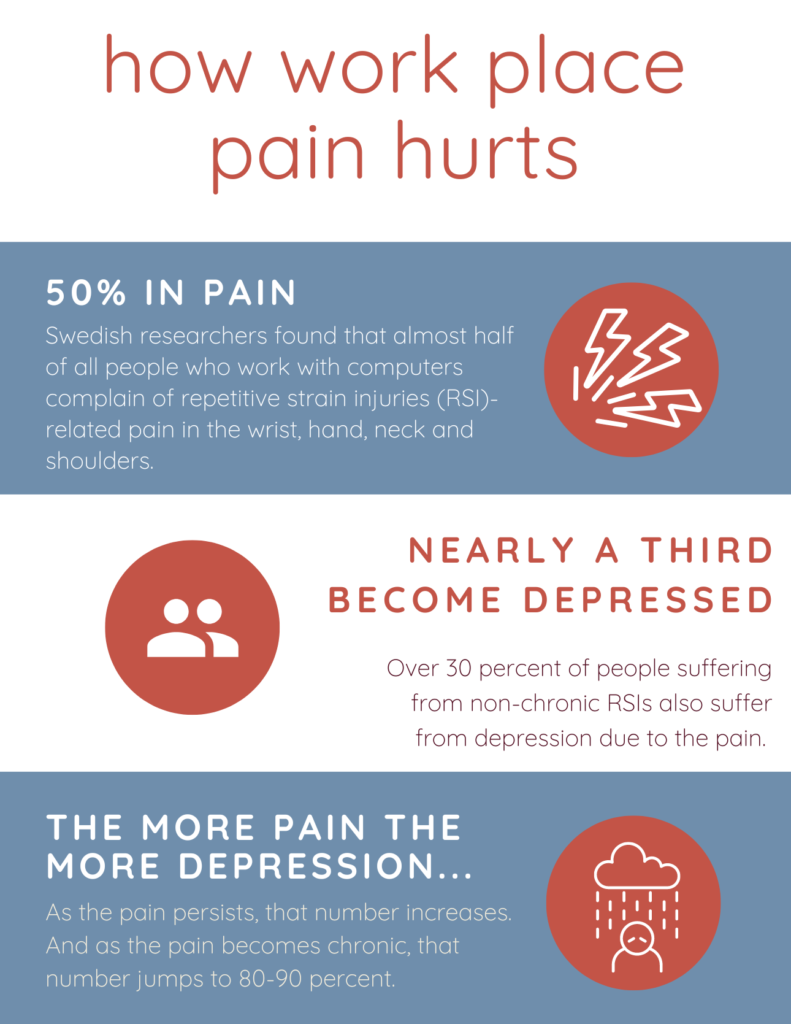Understanding the links between physical discomfort and mental health
It’s not surprising that being in pain makes it difficult for us to feel good. When our bodies are uncomfortable for a long period of time, it affects our wellbeing in many different ways, with pain closely correlated to depression, writes Jennie Stallings is a Partner at ChelseaGREEN and a member of the Movement WELL Advisory Board with the International WELL Building Institute (IWBI).
One reason is because chronic pain and depression share some of the same neurotransmitters, and some of the nerve pathways in the brain and spinal cord. Another factor is that physical discomfort often prevents us from exercising or moving in the same way we would if we were pain-free. If you were previously active, your body is used to the feel-good chemicals that exercise releases; when you stop exercising, endorphin levels plummet. In general, living with pain contributes to high levels of stress hormones, low energy, mood disorders, and reduced cognitive performance. Continued discomfort can also manifest as physical symptoms, such as headaches, fatigue or an upset stomach. All of these things make life less enjoyable and increase the likelihood of social isolation. Plus, being depressed intensifies pain itself, creating a viscous circle that’s hard to break.
While we might accept some degree of pain in times of illness or injury, pain caused by poor ergonomics in the workplace is a significant, but preventable problem, which needs to be rectified before it becomes chronic.

Discomfort in the workplace
Because the majority of people spend around a third of their lives at work, this is often where problems develop. While more companies are recognising the importance of ergonomics and wellbeing, changes are still needed to tackle some of the bigger issues and create the right environment for people to thrive.
Here are some facts:
- Approximately 1.71 billion people worldwide suffer from musculoskeletal disorders (MSD), according to the World Health Organisation. Lower back pain is the most prevalent, and the main reason individuals leave the workforce early.
- According to Public Health England, MSDs are responsible for 30 million working days lost in the UK each year, causing a substantial blow to the economy.
- Swedish researchers found that almost half of all people who work with computers complain of repetitive strain injuries (RSI)-related pain in the wrist, hand, neck and shoulders.
- 33 percent of workers with RSI are below 45 years old.
- In a 2008 report by the BLS, 60 percent of computer workers in the US have wrist pain. One reason for this is poor ergonomics, with 51.2 percent of these employees stating that their keyboards are placed too high.
- More women have poor office health compared to men. A workforce survey by the Federal Institute for Occupational Safety and Health found that 63.5 percent of women experience neck and shoulder pain while only 39.7 percent of men do. The same goes for back pain, which is more common in women (51.4 percent) than men (44 percent).

If we take RSI, this is a gradual build-up of damage to muscles, tendons, and nerves caused by common repetitive motions. For example, using a computer mouse, typing, and maintaining the same posture for long periods of time. Over 30 percent of people suffering from non-chronic RSIs also suffer from depression due to the pain. As the pain persists, that number increases. And as the pain becomes chronic, that number jumps to 80-90 percent.
Symptoms of RSI are generally felt in the hands, wrists, shoulders, head, back, neck, eyes. They include dull and aching pain, sharp or stabbing pain, burning, tingling, or numbness, muscle weakness, temperature sensitivity, and stiffness. RSI can be treated but that’s not the point. We should know enough to be able to mitigate the risks.
Instilling healthier habits by mixing it up
One of the first steps to creating a healthy work environment is ergonomics. Employers have a duty of care to ensure that workstations and equipment are designed to fit the user as safely and efficiently as possible. Case studies from companies that have introduced ergonomic practices report a significant reduction in sickness and disability days, improved return to work rates and lower incidences of stress, anxiety, and depression. So, it’s not only the right thing to do for your workforce, but it comes with clear business benefits as well. Basic ergonomic considerations include investing in sit/stand desks and chairs that provide the right amount of lumbar support, as well as educating staff on the correct seating positions and how to manage screen time. Although in reality, that’s still just the tip of the iceberg.
Another major aspect is physical activity. Promoting movement in the office is one of the most effective ways to make a difference to mental and physical health, and commercial spaces need designing with this in mind. Reducing sedentary behaviour lowers the risk of serious conditions such as obesity, cardiovascular disease, type II diabetes, and cancer. Even smaller bouts of movement and low-intensity physical activity have been shown to provide tangible benefits. Active design looks beyond the individual workspace to how the building as a whole facilitates movement.
A significant factor is making sure management recognise that sitting in a seat doesn’t necessarily equal productivity or efficiency. In fact, the opposite can be true. When we take a movement break, we return to a task feeling refreshed, focused and better able to retain information. An office can have the most forward-thinking design and inspiring areas to interact, but nothing will change if an employer’s expectations are linked to how long staff sit at a desk.
Every workplace is different, and working with a wellness expert can help with setting specific goals. The strategy then needs to be communicated properly and the support offered, so people are empowered to make new behaviours a habit.
If you’re an employer
- Provide ergonomic workstations that are set-up individually to help staff sit or stand comfortably. And, make sure employees know how to use the ergonomic tools. Schedule regular training and wellness session.
- Make a feature of the stairs, keeping them well-lit and well signposted so people are encouraged to use them.
- Implement incentive programmes or internal competitions and ask the team what rewards they would like to see.
- Lead by example so change happens from the top down.
- Staff should be encouraged to move around by taking postural breaks, switching positions, and having walking meetings.
If you’re an employee or WFH
- Incorporate regular stretching, wiggle your fingers and flex your wrists.
- Maintain a neutral seated posture, sitting with your neck and shoulders straight, elbows at a right angle, wrists straight, lower back supported on the backrest of the chair, 90o at the hips, 90o at the knees, and feet flat.
- Change postures by standing or even reclining for a bit while working.
- Change the position of your ergonomic tools as they day goes on. Bring the work to you, don’t go to it.
- Don’t sit hunched over a laptop. Maintain the correct eye level and elevate it with a laptop stand if needed.
- Follow the 20/20/20 rule – for every 20 minutes spent looking at a computer screen, spend 20 seconds looking at something else 20 feet away.
- Use additional task lighting where required and minimise glare from direct sunlight coming from open windows.
- If you’re on the phone a lot, use a headset to avoid straining your neck, shoulders, and arms.
